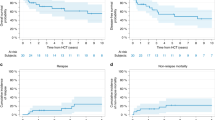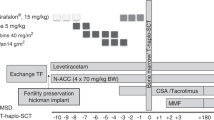Abstract
In total, 17 pediatric patients with hematologic malignancies (n=14) and Fanconi anemia (FA) (n=3) underwent haploidentical SCT with T-cell depletion. The patients were conditioned with reduced-intensity regimens, and CYA was used for GVHD prophylaxis. Successful engraftment occurred in 16 patients (94%). One patient failed to achieve a primary engraftment. Another patient rejected the first SCT after 10 weeks and had a successful second transplant. Of all engrafted patients, only one developed severe acute GVHD. Ten patients were alive at a median follow-up of 18 months (range, 5–62 months). The 5-years’ OS was 53.8%. The three patients with FA are currently well with full-donor chimerism at 16, 6 and 5 months post transplant, respectively. The OS of 14 patients with high-risk hematologic malignancies was 47.6%. Three patients died as a result of post transplant leukemia relapse. CMV infection, GVHD and organ injury were other causes of mortality. Haploidentical SCT was found to be an alternative feasible treatment in Uruguay for patients who need allogenic transplantation but lack an HLA-identical family donor. It should be considered as an early option in FA patients before transformation or significant exposure to blood products.
This is a preview of subscription content, access via your institution
Access options
Subscribe to this journal
Receive 12 print issues and online access
$259.00 per year
only $21.58 per issue
Buy this article
- Purchase on Springer Link
- Instant access to full article PDF
Prices may be subject to local taxes which are calculated during checkout


Similar content being viewed by others
References
Castillo LA, Fluchel M, Dabezies A, Pieri D, Brockhorst N, Barr R . Childhood cancer in Uruguay: 1992–1994. Incidence and mortality. Med Pediatr Oncol 2001; 37: 400–404.
Handgretinger R, Chen X, Pfeiffer M, Mueller I, Feuchtinger T, Hale GA et al. Feasability and outcome of reduced intensity conditioning in haploidentical transplantation. Ann NY Acad Sci 2007; 1106: 279–289.
Ruggeri L, Capanni M, Urbani E, Perruccio K, Shlomchik WD, Tosti A et al. Effectiveness of donor natural killer cell alloreactivity in mismatched hematopoietic transplants. Science 2002; 295: 2097–2100.
Stern M, Ruggeri L, Mancusi A, Bernardo ME, de Angelis C, Bucher C et al. Survival after T cell-depleted haploidentical stem cell transplantation is improved using the mother as donor. Blood 2008; 112: 2990–2995.
Glucksberg H, Storb R, Fefer A, Buckner CD, Neiman PE, Clift RA et al. Clinical manifestations of graft-versus-host disease in human recipients of marrow from HL-A-matched sibling donors. Transplantation 1974; 18: 295–304.
Filipovich AH, Weisdorf D, Pavletic S, Socie G, Wingard JR, Lee SJ et al. National Institutes of Health consensus development project on criteria for clinical trials in chronic graft-versus-host disease: I, diagnosis and staging working group report. Biol Blood Marrow Transplant 2005; 11: 945–956.
Hough R, Cooper N, Veys P . Allogeneic haemopoietic stem cell transplantation in children: what alternative donor should we choose when no matched sibling is available? Br J Hematol 2009; 147: 593–613.
Rocha V, Locatelli F . Searching for alternative hematopoietic stem cell donors for pediatric patients. Bone Marrow Transplant 2008; 41: 207–214.
Copelan E . Hematopoietic stem-cell transplantation. N Engl J Med 2006; 354: 1813–1826.
Barker J, Krepski, TP, DeFor TE, Davies SM, Wagner JE, Weisdorf DJ . Searching for unrelated donor hematopoietic stem cells: availability and speed of umbilical cord blood versus bone marrow. Biol Blood Marrow Transplant 2002; 8: 257–260.
Grewal SS, Barker JN, Davies SM, Wagner JE . Unrelated donor hematopoietic cell transplantation: marrow or umbilical cord blood? Blood 2003; 101: 4233–4244.
Ball LM, Lankester AC, Bredius RGM, Fibbe WE, van Tol MJD, Egeler RM . Graft dysfunction and delayed immune reconstitution following haploidentical peripheral blood hematopoietic stem cell transplantation. Bone Marrow Transplant 2005; 35: S35–S38.
Handgretinger R, Klingebiel T, Lang P, Schumm M, Neu S, Geiselhart A et al. Megadose transplantation of purified peripheral blood CD34(+) progenitor cells from Haploidentical HSCT in children HLA-mismatched parental donors in children. Bone Marrow Transplant 2001; 27: 777–783.
Lang P, Greil J, Bader P, Handgretinger R, Klingebiel T, Schumm M et al. Long-term outcome after haploidentical stem cell transplantation in children. Blood Cells Mol Dis 2004; 33: 281–287.
Chen X, Hale GA, Barfield R, Benaim E, Leung WH, Knowles J et al. Rapid immune reconstitution after a reduced-intensity conditioning regimen and a CD3-depleted haploidentical stem cell graft for paediatric refractory haematological malignancies. Br J Haematol 2006; 135: 524–532.
Reisner Y, Martelli MF . Tolerance induction by ‘megadose’ transplants of CD34+ stem cells: a new option for leukemia patients without an HLA-matched donor. Curr Opin Immunol 2000; 12: 536–541.
Luznik L, O’Donnell PV, Symons HJ, Chen AR, Leffell MS, Zaurak M et al. HLA-haploidentical bone marrow transplantation for hematologic malignancies using nonmyeloablative conditioning and high-dose, posttransplantation cyclophosphamide. Biol Blood Marrow Transplant 2008; 14: 641–650.
Klingebiel T, Cornish J, Labopin M, Locatelli F, Darbyshire P, Handgretinger R et al. Results and factors inuencing outcome after fully haploidentical hematopoietic stem cell transplant in children with very-high risk acute lymphoblastic leukemia—impact of center size: an analysis on behalf of the Acute Leukemia and Pediatric Disease Working Parties of the European Blood and Marrow Transplant group. Blood 2010; 115: 3437–3446.
Acknowledgements
We thank Rupert Handgretinger, MD, for his continued advice and support, Eduardo Speranza for helping prepare the manuscript and our nursing staff for its dedication toward patient care.
Author information
Authors and Affiliations
Corresponding author
Ethics declarations
Competing interests
The authors declare no conflict of interest.
Rights and permissions
About this article
Cite this article
Dufort, G., Pisano, S., Incoronato, A. et al. Feasibility and outcome of haploidentical SCT in pediatric high-risk hematologic malignancies and Fanconi anemia in Uruguay. Bone Marrow Transplant 47, 663–668 (2012). https://doi.org/10.1038/bmt.2011.148
Received:
Revised:
Accepted:
Published:
Issue Date:
DOI: https://doi.org/10.1038/bmt.2011.148
Keywords
This article is cited by
-
Haploidentical hematopoietic stem cell transplantation in children with high-risk hematologic malignancies: outcomes with two different strategies for GvHD prevention. Ex vivo T-cell depletion and post-transplant cyclophosphamide: 10 years of experience at a single center
Bone Marrow Transplantation (2016)
-
Refinement of treatment strategies in ex vivo T-cell-depleted haploidentical SCT for pediatric patients
Bone Marrow Transplantation (2015)



